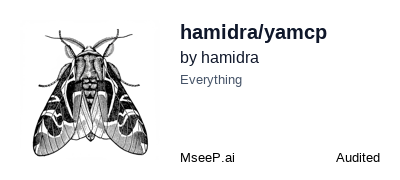YAMCP (YAM-C-P) is a command-line tool for organizing and managing MCP servers as local workspaces. It seamlessly connects to multiple MCP servers, local or remote, grouping them into a unified workspace exposed as Yet Another MCP server (YAM) for AI applications. You can create dedicated workspaces based on specific functionality (e.g., a YAM workspace for coding, design, research, ...) or based on the AI apps that consume servers (e.g., a YAM for Cursor, Claude, Windsurf) or any other combination in between. In addition, it simplifies monitoring and debugging MCP servers by centralizing all server communication logs in a single store, eliminating the need to dig through each AI client app’s logs separately.
# Install YAMCP
npm install -g yamcp # or use npx yamcp
# Import servers (choose one)
yamcp server import [config] # import servers from config file (see src/example-servers.json for format)
yamcp server add # or add manually
# create workspaces (e.g. a yam for coding, design, data, ...)
yamcp yam create
# Run workspace in your AI app
yamcp run <yam-workspace-name>- MCP Servers: Remote or local servers that provide Model Context Protocol services
- Workspaces (YAMs): Collections of MCP servers grouped together to be shared with AI Apps (e.g. a workspace for coding, writing, design, magic making!)
- Gateway: A local MCP server that manages connections to configured MCP servers in a workspace and exposes them through a unified server to AI App's MCP clients
With YAMCP, you can:
- Create workspaces to group MCP servers by AI application (e.g. Cursor, Claude, GitHub Copilot)
- Group servers by workflow purpose (e.g. software development, data science, technical writing)
- Connect AI apps to a single gateway that provides access to all workspace servers
- Manage and monitor multiple MCP server connections through a unified interface
- Track all server communications with detailed logging and debugging capabilities
yamcp [command] [subcommand] [flags]Available top-level commands:
server- Manage MCP providersyam- Manage workspaces (yams)run- Run the gateway with a workspacelog- View the server log location
yamcp server add # Add a new MCP server (interactive)
yamcp server list # List all configured servers and their status
yamcp server remove # Remove a server configuration
yamcp server import # Import server configurations from a JSON fileyamcp yam create # Create a new workspace (interactive)
yamcp yam list # List all workspaces or show specific workspace details
yamcp yam edit # Modify an existing workspace configuration
yamcp yam scan # Scan workspaces
yamcp yam delete # Delete a workspaceyamcp run <yam-workspace-name> # Start the gateway with specified workspace
yamcp log # View server communication logs| Command | Description | Example |
|---|---|---|
server add |
Add a new MCP server | yamcp server add |
server list |
List configured servers | yamcp server list |
server remove |
Remove a server | yamcp server remove [name] |
server import |
Import server config | yamcp server import [config] |
yam create |
Create workspace | yamcp yam create |
yam list |
List workspaces | yamcp yam list |
yam list --name |
Show workspace details | yamcp yam list --name my-workspace |
yam edit |
Edit workspace | yamcp yam edit |
yam scan |
Scan workspace | yamcp yam scan [workspace-name] |
yam delete |
Delete workspace | yamcp yam delete [workspace-name] |
run |
Start gateway | yamcp run <workspace-name> |
log |
View logs | yamcp log |
🖥️ YAMCP UI (created by @eladcandroid)
YAMCP UI provides an intuitive web interface to manage your MCP servers and workspaces through a universal dashboard.
# Run directly with npx (recommended)
npx yamcp-ui
# Or install globally
npm install -g yamcp-ui
yamcp-uiRefer to the project repo for full documentation: https://github.com/eladcandroid/yamcp-ui.
graph TB
CLI[CLI Commands]
GW[McpGateway]
GS[GatewayServer]
GR[GatewayRouter]
LOG[Logger]
STORE[(Store)]
AI_APP[AI App]
%% CLI Command Flow
CLI -->|manages| STORE
CLI -->|runs| GW
%% Gateway Components
GW -->|uses| GS
GW -->|uses| GR
GW -->|logs| LOG
%% Server & Router
GS -->|stdio transport| AI_APP
GR -->|connects to| SERVERX
GR -->|connects to| SERVERY
%% Data Store
STORE -->|loads config| GW
%% External MCP Servers
subgraph "Workspace Servers"
SERVERX["Server x (Stdio)"]
SERVERY["Server y (SSE)"]
end
%% Store Components
subgraph "Configuration Store"
PROVIDERS[(Provider Config)]
WORKSPACES[(Workspace Config)]
end
STORE --- PROVIDERS
STORE --- WORKSPACES
classDef primary fill:#2374ab,stroke:#2374ab,color:#fff
classDef secondary fill:#ff7e67,stroke:#ff7e67,color:#fff
classDef store fill:#95b8d1,stroke:#95b8d1,color:#fff
class GW,GS,GR primary
class CLI,AI_APP secondary
class STORE,PROVIDERS,WORKSPACES store
The diagram shows the main components of the YAMCP system:
- CLI Commands: User interface for managing servers and workspaces
- McpGateway: Core component that coordinates the Gateway Server and Router
- GatewayServer: Handles communication with AI Apps via stdio transport
- GatewayRouter: Manages connections to configured MCP servers
- Logger: Provides consolidated logging for all components
- Store: Manages configuration for providers and workspaces
- MCP Servers: Both local (stdio) and remote (SSE) servers that provide MCP services


